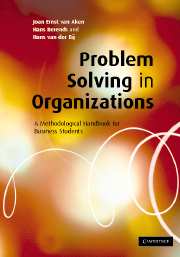Book contents
- Frontmatter
- Contents
- List of figures
- List of boxes
- Preface
- Part I Fundamentals
- 1 Scope and nature of this handbook
- 2 Problem-solving projects in organizations
- 3 Design-focused business problem-solving
- 4 Theory-based business problem-solving
- Part II The problem-solving project
- Part III On methods
- Part IV Conclusion
- References
- Index
4 - Theory-based business problem-solving
from Part I - Fundamentals
Published online by Cambridge University Press: 04 December 2009
- Frontmatter
- Contents
- List of figures
- List of boxes
- Preface
- Part I Fundamentals
- 1 Scope and nature of this handbook
- 2 Problem-solving projects in organizations
- 3 Design-focused business problem-solving
- 4 Theory-based business problem-solving
- Part II The problem-solving project
- Part III On methods
- Part IV Conclusion
- References
- Index
Summary
Theory-based problem analysis and solution design
The business problem-solving (BPS) methodology presented in this handbook is theory-based. As said in Chapter 1, problem analysis and solution design should be based on comprehensive, critical and creative use of the literature. Business problem-solving can be informed by many sources of knowledge and inspiration, but an important one is the scholarly literature on organization and management and on the various business functions like marketing, operations, product development and management accounting. We will see in Chapter 5 that an important – and often quite difficult – aspect of problem definition in BPS is to define it as a special type of problem within a business system. Students have to do this in order to be able to focus their literature search on the right type of problem and business system (as there is, of course, no literature on their specific problem).
Next to the scholarly literature, there is also management literature, written by practitioners for practitioners (see Chapter 11.2). This literature can be an important source of inspiration for solution design. However, often its major weakness is the limited evidence given. That makes it difficult for students to make evaluations of designs based on this type of literature on paper. Or, in other words, it is difficult to judge how the proposed business solution will work in their specific setting.
The scholarly literature also has its limitations. A large segment of it has a quantitative nature and is, therefore, strongly reductionistic.
- Type
- Chapter
- Information
- Problem Solving in OrganizationsA Methodological Handbook for Business Students, pp. 33 - 38Publisher: Cambridge University PressPrint publication year: 2007



